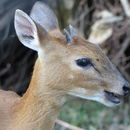en
names in breadcrumbs


These animals are very wary and rarely viewed in the wild and not much is known about them due to their elusive nature. Population estimates range from 1,000 to 10,000 animals. They have a pecular jerky manner in the way they walk and run. They are sometimes confused with hog deer, but their movements distinguish the two easily (MacDonald, 1984).
Perception Channels: tactile ; chemical
T. quadricornis is currently listed by the IUCN as vulnerable and is on CITES Appendix III in Nepal. The habitat of this species is being fragmented by human activities (Nowak, 1999).
US Federal List: no special status
CITES: appendix iii
IUCN Red List of Threatened Species: vulnerable
No negative affects on humans have been reported.
T. quadricornis may be eaten by people in India and Nepal, but it is reportedly not as good to eat as are other antelopes. This species is sought after by trophy hunters because of its unique horns. In India ecotours are offered and one the top attractions is often the four-horned antelope. It is also a species sought after by zoos. (Nowak, 1999)
Positive Impacts: food ; body parts are source of valuable material; ecotourism
The role of this species within its ecosystem has not been evaluated. Because it is a prey species, it probably affects predator populations to the extent that those predators rely upon T. quadricornis for food. It also has a likely role in affecting plant communities through its browsing behavior.
T. quadricornis is primarily a grazer. The primary foods of these antelope are grasses, shoots, and fruit. They are rarely found far from water (Nowak, 1995).
Plant Foods: leaves; fruit
Primary Diet: herbivore (Folivore , Frugivore )
Tetracerus quadricornis is found only in India and Nepal (Nowak, 1999; Walker, 1995).
Biogeographic Regions: oriental (Native )
Four-horned antelopes are found primarily in wooded areas in India. The species is still widely distributed throughout its range. T. quadricornis uses the hilly country and tall grassy areas for shelter. It prefers open forests and is rarely seen, dashing into thick cover at the first sign of danger (MacDonald, 1984).
Habitat Regions: temperate
Terrestrial Biomes: forest ; mountains
T. quadricornis in captivity can live up to 10 years of age (Nowak, 1999).
Range lifespan
Status: captivity: 10 (high) years.
Average lifespan
Status: captivity: 10.0 years.
Average lifespan
Status: wild: 10.0 years.
T. quadricornis weighs between 15 and25 kg. The body length is 80-110 cm, with a shoulder height of 55-65 cm, and a tail length of 10-15cm. The hair is short, coarse, and thin, with sexually dimorphic brownish color above and lighter on sides. The insides of the legs are white along with the middle of the belly. Males are dull-red brown above, with white below, and have a dark stripe that runs down the front of each leg. Older males are yellowish. Females typically are a brownish-bay color. The horns, only on males, are smooth, short, and conical. The posterior set range from 80 to100 mm in length. The front two are typically 25-38 mm long, and sometimes only a raised black area of skin is present. The muzzle and outer surface of the ears are blackish brown. The small hooves are split and rounded in the front. Four-horned Antelopes are unique, being the only bovids with four horns (Nowak, 1999; Walker, 1995; Macdonald, 1984).
Range mass: 15 to 25 kg.
Range length: 80 to 110 cm.
Other Physical Features: endothermic ; bilateral symmetry
The predators of T. quadricornis are tigers, leopards, wolves, dhole, and small cats. Information on anti-predator adaptations are not available, but they are likely to rely primarily on vigilance and speed to escape predators.
Known Predators:
Males can be extremely aggressive to one another during the rut. Further information on the mating system of this bovid is not available.
Mating takes place during the rainy season from July to September. The gestation period is 7.5 to 8 months (Grizmek, 1990). Usually one or two young per litter are born with an average weight of about 1 kg each (Nowak, 1999).
Breeding season: The breeding season is July to September, and births occur from March to May.
Range number of offspring: 1 to 2.
Average number of offspring: 1.83.
Range gestation period: 7.6 to 8.1 months.
Key Reproductive Features: seasonal breeding ; gonochoric/gonochoristic/dioecious (sexes separate); sexual ; fertilization (Internal ); viviparous
Average birth mass: 1044 g.
Average number of offspring: 1.5.
Average age at sexual or reproductive maturity (female)
Sex: female: 365 days.
As in all mammals, the female nurses her young. Although information is not available on the specifics of parental care in this species, it is common for Artiodactyls to produce precocious young. Male parental care is typically not associated with bovids.
Parental Investment: precocial ; female parental care